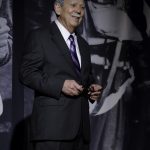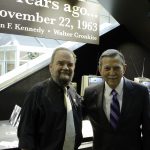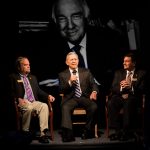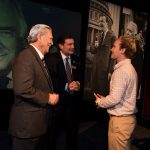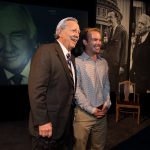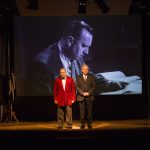By: Bethany Vonseggern
Walter Cronkite a visionary. A kid from St. Joe. A journalist with high integrity known for delivering the news with honesty and grace. Considered a momentous figure in history Cronkite has made an impact on the lives of many Americans one of which is Western’s president, Dr. Robert Vartabedian.
“He was in my opinion one of the most significant figures of the 20th century, his life is worth celebrating, particularly today,” said Vartabedian. “I don’t think we’ll ever see his equal in journalism again. He’s one person the more I study the more I admire him in terms of being a journeyman journalist who really understood his craft from a young age.”
To celebrate Cronkite, Vartabedian wrote an artistic one-person, 22-minute multimedia performance that depicted an interview Larry King did with Cronkite on the “Larry King Live” show a year after the tragic events of September 11, 2001. Vartabedian adapted the transcript from the interview to a stage performance that involved an actor playing Walter Cronkite along with visual aids on film screens and audio of the original interview.
For a multimedia show such as this to come to fruition Vartabedian had to further research Cronkite, write several transcripts before arriving at the version we have seen on stage as well as recruiting a stellar production team to connect all aspects of the show. With the help of Western’s dean of fine arts Dr. Bob Willenbrink and Western Institute’s dean and executive director Gordon Mapley a technical and musical team were created.
In search of Cronkite, the production team held auditions locally in St. Joseph in addition to larger cities such as St. Louis and Kansas City before deciding on Kansas City based actor, Jim Korinke. Korinke, a 47-year professional actor, said after reading the script he felt connected to Cronkite and was lucky to be part of this show.
“When they called to offer me the role I just leapt to at the opportunity to do it,” Korinke said. “The rest has been the best ride of my professional career. I’ve have never been associated with anything that I consider this important.”
WIllenbrink, director of “Cronkite” described the experience of director as an artistic challenge. He relished working with the multimedia aspect of the show and watching the videos and music come alive on stage setting the mood. He directed Korinke to make minimal movement on stage, which mainly consisted of walking across the stage. The melancholy temperament was obvious through the emotional expression on Cronkite’s face along with the musical score and multimedia visuals.
The success of “Cronkite” quickly took off leading the Western team to take the show to the Lincoln Center in New York City, the Newseum in Washington D.C. and Kansas City. In attendance at these shows were talent agents and Cronkite’s family members and friends. Willenbrink describes the experience of taking the show to other venues as exciting and rewarding.
“We were excited to share this with people of New York. Doing it near the Lincoln Center gave it credibility and value to our name being in New York with the Cronkite’s and others. That kind of exposure is invaluable,” Willenbrink said.
- Harry and Walter MWSU – Copyright Jeni Swope 2015


